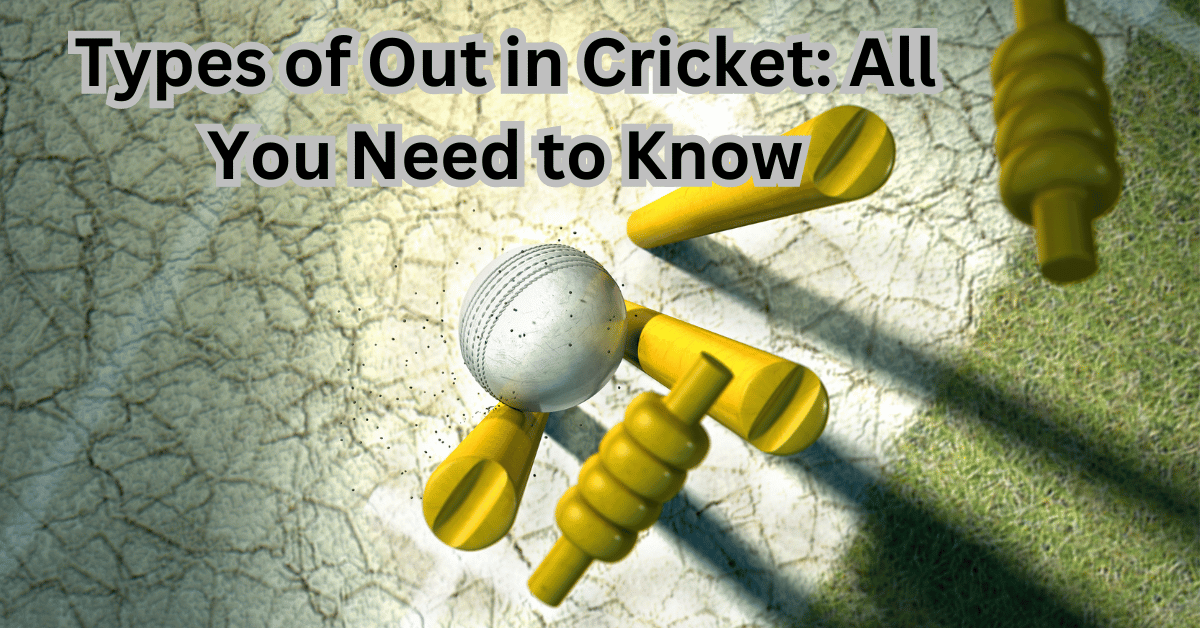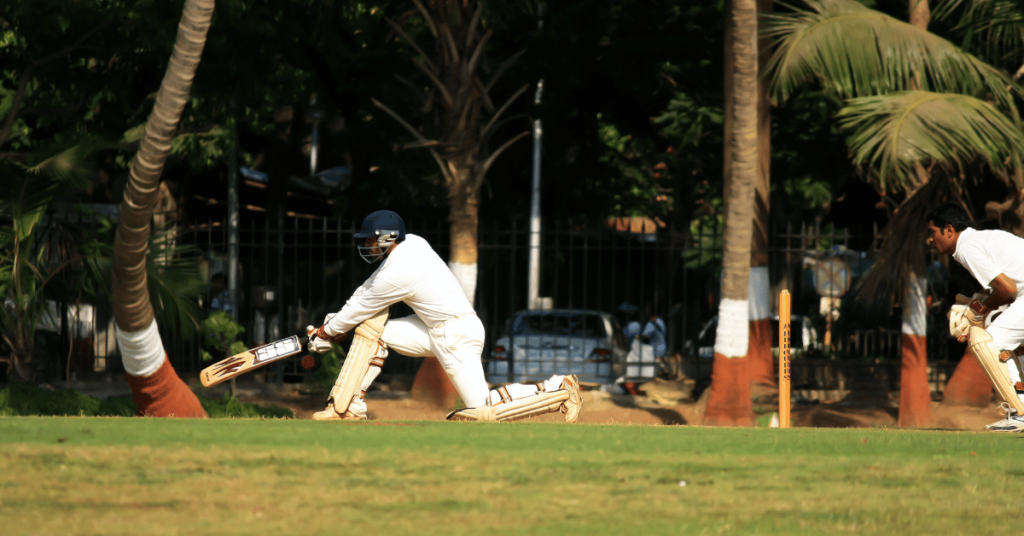Last updated on October 24th, 2023 at 08:27 am
Types of Out in Cricket: All You Need to Know

Dismissal meaning in cricket
In cricket, the term “dismissal” refers to the process by which a batsman is declared “out” and must leave the field of play. There are various ways in which a batsman can be dismissed, each with its own specific rules and circumstances. The most common forms of dismissal include being bowled (when the bowler hits the stumps with the ball), caught (when a fielder catches the ball hit by the batsman without it touching the ground), and leg-before-wicket (LBW, when the ball would have hit the stumps but for any part of the batsman’s body obstructing it). Other forms of dismissal include being stumped (when the wicketkeeper removes the bails while the batsman is out of their crease), run out (when the fielding side successfully hits the stumps with the ball before the batsman reaches the crease), and being hit wicket (when the batsman accidentally dislodges the stumps while playing a shot or setting off for a run). The concept of dismissal is a fundamental aspect of cricket, and it plays a pivotal role in the dynamics of the game, shifting momentum and determining the fate of individual players and teams.
Embark on the Fun Ride: Join the Excitement at Fun88! Don’t miss out on the thrill – register now at Fun88
How many types of out in cricket
In cricket, there are ten primary ways a batsman can be declared “out.” These modes of dismissal include:
Bowled Out in cricket
In cricket, a batsman is declared “out bowled” when a delivery from the bowler hits the stumps located behind them, either directly or after making contact with the bat, pad, or any other equipment, including the helmet.
Caught
In cricket, one of the most common methods of dismissal is being “caught out.” This occurs when a batsman strikes the ball with their bat, and a fielder or wicketkeeper catches it before it makes contact with the ground. There are variations of the caught dismissal, such as “caught and bowled” when the bowler takes the catch, “caught behind” when caught by the wicketkeeper or in the slip cordon, and simply “caught out” when a fielder catches the ball elsewhere on the field.

Leg Before Wicket (LBW)
In cricket, a relatively common method of dismissal is known as “leg before wicket” or LBW. This occurs when the ball makes contact with the batter’s pad or glove while they are positioned in line with the stumps. However, it is the responsibility of the umpire to assess whether the ball would have hit the stumps had it not struck the batter’s pad or glove. It’s important to note that if the ball pitches outside the leg stump, a player cannot be declared LBW, as per the rules of the game. Moreover, in the modern era of cricket, players have the option to challenge the umpire’s LBW decision through reviews if they believe the ball was going to hit the stumps or otherwise.
Run Out in cricket
In cricket, a run-out occurs when a batsman tries to score a run but doesn’t make it to the crease before the fielding side either directly hits the stumps or returns the ball to the wicketkeeper, who then dislodges the stumps with the ball. If the decision regarding a run-out is too close to determine with certainty, the third umpire is consulted, and technology is used to make the final judgment.
Stumped
The method of dismissal known as “stumped” typically occurs when a batsman ventures out of their crease to play a delivery, but the ball goes past them and lands in the wicketkeeper’s hands. The wicketkeeper then dislodges the bails before the batsman can return to the crease, resulting in a stumping. Stumpings are more likely to happen when a spinner or slow bowler is in action, as they have the opportunity to stand closer to the stumps and capitalize on the batsman leaving their crease and missing the ball.
Hit the ball twice
Another uncommon mode of dismissal, known as “hit the ball twice,” occurs when a batsman deliberately or accidentally hits the ball twice during their innings. If a batsman makes contact with the ball using their bat or any other part of their body on two separate occasions, it results in a dismissal known as “hit the ball twice.”
Handled the Ball
When a batsman deliberately touches the ball with a hand that is not holding the bat to prevent their dismissal, it is known as “obstructing the field.” This rare mode of dismissal involves the batsman obstructing the fielding side’s attempt to take a wicket by physically interfering with the ball’s path or preventing a fielder from making a legitimate attempt to field it. It’s an infrequent form of dismissal that requires a specific set of circumstances to occur.
Obstructing the Field
According to Law 37 of the Laws of Cricket set by the Marylebone Cricket Club (MCC), a batsman can be dismissed if they intentionally obstruct the field or engage in actions and utterances that distract the fielding side.
Timed Out in cricket
Timed out” is a relatively rare mode of dismissal, especially in international cricket. This occurs when a batsman takes more than three minutes to prepare and face a ball while the bowling side is ready to resume play. If a batsman exceeds the three-minute limit, they are deemed “timed out” and must leave the field. While it’s not a common occurrence in international cricket, it has occurred on a few occasions in first-class cricket.
Retired Out in cricket
“Retired out” occurs when a batsman voluntarily leaves the field without being officially dismissed by the umpire. Unlike “retired hurt,” the batsman isn’t leaving due to injury or illness but rather decides on their own accord to exit the field. This type of dismissal typically occurs when a team wants to increase their scoring rate, and the batsman believes that their continued presence is hindering the team’s progress and becoming counterproductive.
What is the “Mankaded” dismissal, and why does it often generate controversy in the cricketing world?
The “Mankaded” dismissal in cricket occurs when a bowler runs out the non-striking batsman at the non-striker’s end before delivering the ball, if the batsman has left the crease too early. This type of dismissal is named after Indian cricketer Vinoo Mankad, who famously used this tactic. It often generates controversy because some consider it unsportsmanlike, arguing that the batsman should be warned first. However, according to the laws of the game, it is a legitimate form of dismissal if the batsman is attempting to gain an unfair advantage by leaving the crease early. The controversy surrounding this dismissal stems from the balance between the spirit and the letter of the game’s rules.

Sachin Tendulkar
Frequently Asked Questions (FAQ)
How many methods exist for a batsman to be dismissed in the sport of cricket?
There are ten methods by which a batsman can get out in cricket.
How is a run-out defined in the game of cricket?
A run-out in cricket occurs when a batsman attempting to complete a run fails to reach the crease before the fielding side either hits the stumps directly or returns the ball to the wicketkeeper, who then disturbs the stumps prior to the batsman reaching the crease.














